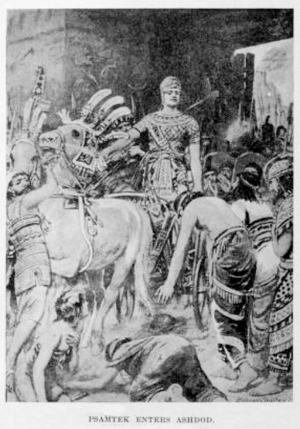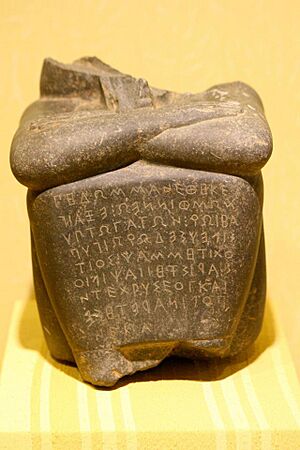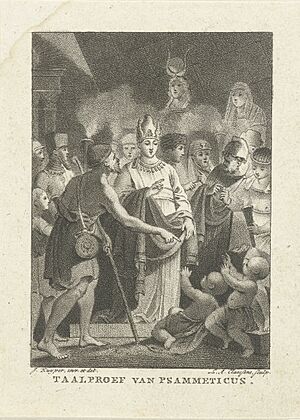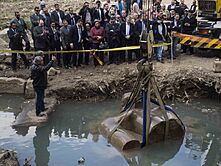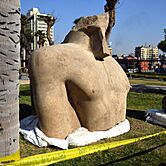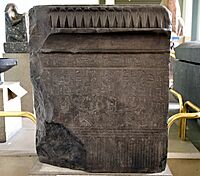Psamtik I facts for kids
Quick facts for kids Psamtik I |
|
|---|---|
| Psammetichus | |
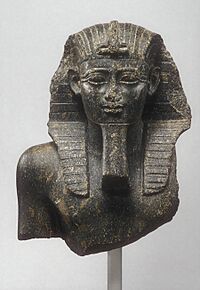
Bust of Psamtik I, Metropolitan Museum of Art
|
|
| Pharaoh | |
| Reign | 664–610 BC (26th Dynasty) |
| Predecessor | Necho I |
| Successor | Necho II |
| Consort | Mehytenweskhet |
| Children |
|
| Father | Necho I |
| Mother | Queen Istemabet |
| Died | 610 BC |
Wahibre Psamtik I was an important pharaoh who ruled ancient Egypt from 664 to 610 BC. He was the first pharaoh of the Twenty-sixth Dynasty of Egypt, also known as the Saite period. He ruled from the city of Sais in the Nile Delta. Psamtik I helped bring Egypt back together after a period of being controlled by different groups. He was first put in charge by the Assyrians, but he later gained more power as the Assyrian Empire became weaker.
Contents
Psamtik's Name
Psamtik's Egyptian name, Psamāṯăk, meant "the man of Meṯek." Meṯek was likely a god. Other ancient people called him different names. The Assyrians called him Pishamilki (Neo-Assyrian Akkadian: 𒁹𒉿𒃻𒈨𒅋𒆠, romanized: Pišamilki). The ancient Greeks knew him as Psammētikhos, and the Romans called him Psammētichus. He was also sometimes called Nabu-shezibanni (Neo-Assyrian Akkadian: 𒁹𒀭𒀝𒊺𒍦𒀀𒉌) by the Assyrians. This name means "O Nabu, save me!"
Egypt Before Psamtik I
In 671 BC, the powerful Assyrian king Esarhaddon invaded Egypt. This invasion was aimed at the Kushite rulers of the Twenty-fifth Dynasty of Egypt. The Kushites had been in control of southern Egypt. The Assyrians set up a new government in Egypt. They put local Egyptian rulers in charge, creating a group of twelve "kinglets" who ruled the Nile Delta. The Assyrians also made friends with Necho I, the ruler of the city of Sais. Necho I was the strongest of these Delta kinglets.
In 665 BC, the Kushite king Tantamani invaded northern Egypt again. Necho I fought against the Kushites but died in battle. His son, Psamtik I, had to escape to Syria. The next year, in 664 BC, the Assyrians, led by Esarhaddon's son Ashurbanipal, invaded Egypt once more. The Assyrian army took back the city of Memphis. They also attacked Thebes and forced Tantamani out of Egypt. Psamtik I returned to Egypt with the Assyrian army. The Assyrians made him the ruler of Sais and Memphis. He also made an agreement with the Assyrians, showing he was under their authority.
Psamtik's Reign and Unification of Egypt
For the first two years, Psamtik I ruled as one of the many small kings under Assyrian control. According to the Greek historian Herodotus, Psamtik I accidentally fulfilled a prophecy. This prophecy said that whoever poured a drink from a bronze cup would become king of all Egypt. After this happened, the other kinglets chased him away from Memphis. He had to hide in the swamps of the Nile Delta.
While in the Delta, Psamtik I received another prophecy. This one said he would rule all Egypt if he used "bronze men from the sea." Starting in 662 BC, Psamtik I connected with Gyges, the king of Lydia. Gyges sent Ionian Greek and Carian soldiers to Egypt. Psamtik I used these soldiers to take back Memphis and defeat the other kinglets. Some of his enemies fled to Libya. Psamtik I might have also received help from Arabs from the Sinai Peninsula.
After defeating his rivals, Psamtik I organized these foreign soldiers. He placed them in important forts. One was at Daphnae in the east to stop attacks. Another was at Elephantine in the south to control trade and prevent Kushite attacks. This military help from Lydia continued until 658 BC. By 657 BC, Psamtik I was in full control of the Nile Delta.
It seems that Psamtik I and the Assyrian king Ashurbanipal remained allies. Psamtik I's wars were mainly against the other small kings in the Delta. The Assyrians were not happy that Psamtik I broke his agreement with them. They also disliked that he removed the other kinglets who were allied with Assyria.
In 656 BC, Psamtik I sent an expedition to Thebes. There, he arranged for his daughter, Nitocris I, to become the next "God's Wife of Amun." This was a very important religious position. This event helped Psamtik I unite all of Egypt under his rule.
Between 655 and 654 BC, Psamtik I fought against Libyan tribes. These tribes had taken control of a large area of land. After winning this war, Psamtik I placed an Egyptian army at Marea. This was to stop any more attacks from the Libyans. By 654 BC, Psamtik I was firmly in control of all Egypt.
According to Herodotus, Psamtik I also led a very long siege of the city of Ashdod. This siege lasted for twenty-nine years.
Later in Psamtik I's reign, the Assyrian Empire began to weaken. After Ashurbanipal died in 627 BC, a power vacuum appeared in the Levant. This allowed the Scythians, who were once Assyrian subjects, to take over the area. Around 623 to 616 BC, the Scythians reached as far south as Judah. Psamtik I met them and convinced them to turn back by offering them gifts.
After this, Psamtik I expanded his military actions into the Levant. He supported the weakening Assyrian Empire against other groups like the Medes and Babylonians. This suggests that Psamtik I and the Assyrians were still allies. Psamtik I died in 610 BC. His son, Necho II, became the next pharaoh.
Experiment to Discover the Origin of Language
The Greek historian Herodotus shared an interesting story about Psamtik I. Herodotus heard that Psamtik wanted to find out where language came from. He decided to do an experiment with two babies. He gave two newborn babies to a shepherd. The shepherd was told not to speak to them at all. He was only to feed and care for them. The pharaoh wanted to hear what their first words would be. He believed their first word would be in the original language of all people.
When one of the children cried "bekós" with arms outstretched, the shepherd told Psamtik. Psamtik concluded that the word was Phrygian. This was because "bekós" sounded like the Phrygian word for "bread." So, they decided that the Phrygians were an older people than the Egyptians. They also thought Phrygian was the first language of humans. There are no other old writings that can prove this story.
Psamtik's Family
Psamtik's main wife was Mehytenweskhet. She was the daughter of Harsiese, who was a very important official called the vizier of the North. Psamtik and Mehytenweskhet had several children. Their children included Necho II, who would become the next pharaoh, and Nitocris I, who became a powerful religious leader.
Discovery of a Giant Statue
On March 9, 2017, archaeologists from Egypt and Germany made an amazing discovery. They found a huge statue, about 26 feet (8 meters) tall, at the Heliopolis site in Cairo. The statue was made of quartzite. It was found in pieces, with parts of the head and chest submerged in water.
At first, people thought the statue might be of Ramesses II. But later, carvings found on the base of the statue confirmed it was Psamtik I. A spokesperson said that if it truly belonged to Psamtik I, it would be the largest statue from the Late Period ever found in Egypt. The head and body parts are planned to be moved to the Grand Egyptian Museum.
The statue was carved in an old, classical style from around 2000 BC. This shows that Psamtik I wanted to bring back the greatness of earlier Egyptian times. Reconstructions of the statue look very similar to a statue of Senusret I. However, the many pieces of the statue show that it was deliberately destroyed at some point. Some broken pieces even show signs of being heated to very high temperatures and then shattered with cold water. This was a common way to destroy large ancient statues.
Gallery
-
Psamtik I kneeling, Louvre Museum



